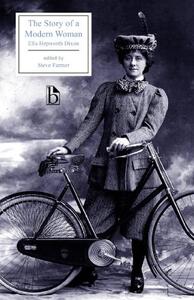
John Sutherland described Ella Hepworth Dixon’s The Story of a Modern Woman as “the greatest unread novel of female struggle of the century”. Published in 1894, it is in Dixon’s own words “a somewhat gloomy study of the struggles of a girl alone in the world and earning her own living”. When her father dies, Mary Erle is left to fend for herself without guidance or money. She initially follows her dream of studying at the Central London School of Art, only to repeatedly fail entry to the Royal Academy. She instead tries her hand at hack writing, churning out magazine articles and penny novels. She is given little latitude to employ any artistic vision, as the publisher demands books that will be accepted by Mudie’s circulating library. Mary cannot understand why her fiction must be bowdlerised so as not to offend her readers, when the most sensational details of divorce cases are reported in the daily newspapers. Presumably, her readers are mainly women, whereas men would be more likely to read the lurid newspaper articles and disseminate a sanitised version deemed suitable for delicate feminine ears.
Although the heaving metropolis of London offers Mary the opportunity to earn a reasonable living, the city is also shown as oppressive and minatory. This Broadview edition helpfully includes a map to show Mary’s trajectory and explains the significance of the various locations. London is in itself a character, and a brutal one at that. Mary is also oppressed by her lover, Vincent Hemming. He demands loyalty from her while he disappears abroad for a year, only to marry a vulgar heiress on his return. Her upper-class friend Alison Ives fares no better. Her fiancé, the sinister Dr Dunlop Strange, impregnates one of his patients who later commits suicide. He represents both the moral and sexual double standard, against which the female protagonists are shown to be honourable, if unhappy. Alison, rather like Ideala in Sarah Grand’s novel, helps her fiancé’s mistress and puts the sisterhood above her sufferings. She proclaims: “If only we were united we could lead the world. But we’re not.” Ella Hepworth Dixon saw this line as the “keynote of the book” and a “plea for a kind of moral and social trades-unionism among women.”
The novel also examines the question of what a woman should do with her life. Mary is “born too late for the simple days of the fifties, when all it behooved a young woman to do was to mind her account-book, read her Tennyson, show a proper enthusiasm for fancy-work stitches, and finally, with many blushes, accept the hand of the first young man who desired to pay taxes and to fulfil the duties of a loyal British subject.” By the 1890s, marriage had fallen out of favour and there was, of course, a superfluity of females, made famous by Gissing’s The Odd Women. Society, however, had not fully come to terms with how else women should fill their lives. Mary’s novel based on her experience is rejected by all the publishers, as nobody wants to read a realistic account of women’s troubles. Instead, she is given a commission to write a “three-volume novel on the old lines–a dying man in a hospital and a forged will in the first volume; and ball and a picnic in the second; and an elopement, which must, of course, be prevented at the last moment by the opportune death of the wife, or the husband–I forget which it is to be–in the last.”
The overall tone of the novel is one of ambivalence. Although Mary achieves her independence and modest literary success, she is unhappy. The conclusion shows her mournfully surveying the London landscape from Highgate Cemetery and contemplating the “dreary battle of life”. This was Dixon’s only novel, but this edition also includes some of her political writing and that of her contemporaries. She never married (unsurprisingly) and became an ardent campaigner for women’s rights. It’s something of a puzzle, therefore, to discover she was a great friend of H G Wells, who was hardly known for his emancipated views. Mary Erle declares: “It is because they suffer so that women have written supremely good fiction.” It is a shame, therefore, that Dixon didn’t write any more.
The Story of a Modern Woman by Ella Hepworth Dixon. Edited by Steve Farmer (Broadview Press)